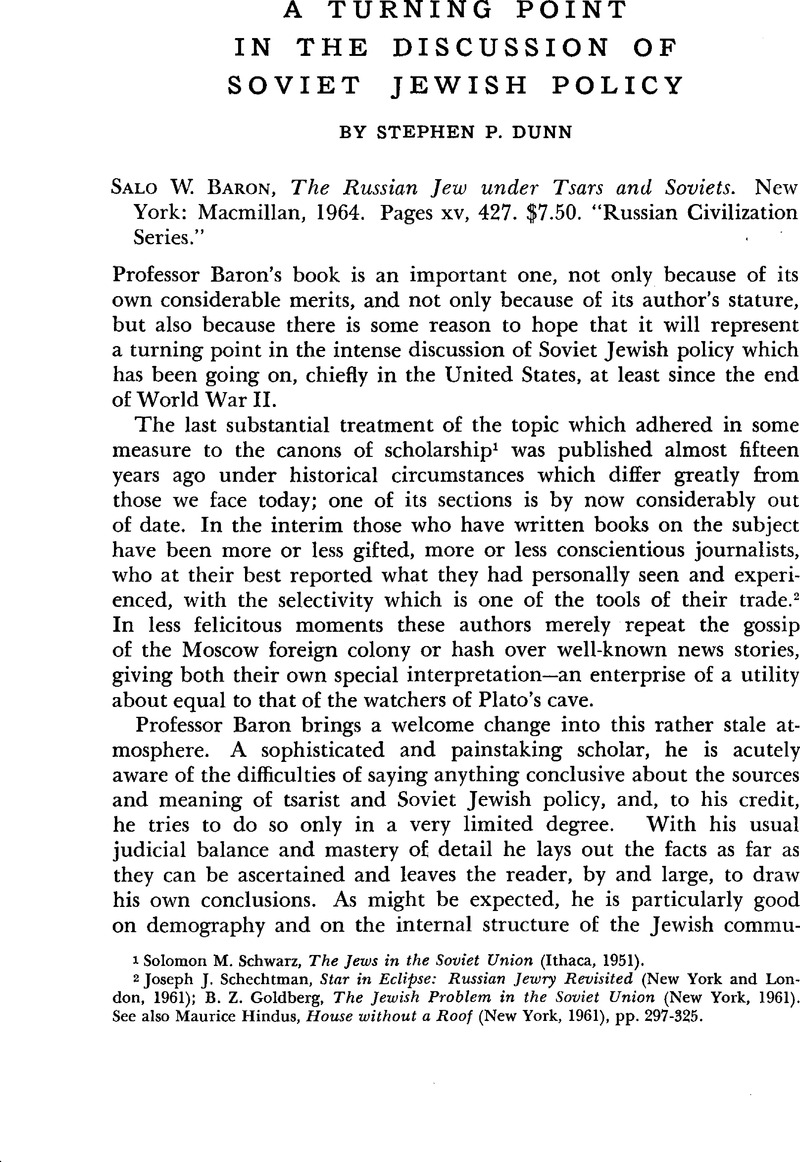No CrossRef data available.
Article contents
A Turning Point in the Discussion of Soviet Jewish Policy
Published online by Cambridge University Press: 27 January 2017
Abstract

- Type
- Review Articles
- Information
- Copyright
- Copyright © Association for Slavic, East European, and Eurasian Studies. 1965
References
1 Schwarz, Solomon M., The Jews in the Soviet Union (Ithaca, 1951 Google Scholar).
2 Schechtman, Joseph J., Star in Eclipse: Russian Jewry Revisited (New York and London, 1961 Google Scholar); Goldberg, B. Z., The Jewish Problem in the Soviet Union (New York, 1961)Google Scholar. See also Maurice, Hindus, House without a Roof (New York, 1961), pp. 297–325 Google Scholar.
3 To my knowledge, no scholarly work dealing except in passing with any aspect of Jewish affairs has been published in the Soviet Union since Lev Zinger's Yiddish monograph (Dos banaite Folk [Moscow, 1941]; cited in Baron, p. 410), which was based on partial results of the 1939 census; according to Baron, this volume was reprinted in Moscow in 1948, with a brief supplement. From 1941 to the present the sources offer only bare statistics. It has been possible, particularly recently, to pick up a few nuggets of information by sifting through the ethnographic literature. We may cite particularly:
V. I., Naulko, “The Present Ethnic Composition of the Population of the Ukrainian SSR,“ Soviet Sociology, III, No. 1 (1964), 18
Google Scholar (originally published in ![]()
![]() , No. 2, 1965, p. 53 (translation forthcoming in Soviet Sociology, Vol. IV, No. 3). The references to Jews in both these articles concern the demographic effect of assimilation. The recently published
, No. 2, 1965, p. 53 (translation forthcoming in Soviet Sociology, Vol. IV, No. 3). The references to Jews in both these articles concern the demographic effect of assimilation. The recently published ![]() , Vol. II, ed. B. H.
, Vol. II, ed. B. H. ![]() (Moscow, 1964); in series
(Moscow, 1964); in series ![]() , contains a section (pp. 832-34) on the Jews which is perfunctory and uninformative to a degree, but at least it is there. The text of other sections is also sprinkled with references to the Jews, none of them very revealing. It is interesting that Soviet ethnographers have been less inhibited in discussing various special Jewish ethnic groups—the Judaeo-Tats or “Mountain Jews” of Dagestan (M.
, contains a section (pp. 832-34) on the Jews which is perfunctory and uninformative to a degree, but at least it is there. The text of other sections is also sprinkled with references to the Jews, none of them very revealing. It is interesting that Soviet ethnographers have been less inhibited in discussing various special Jewish ethnic groups—the Judaeo-Tats or “Mountain Jews” of Dagestan (M. ![]() , the Bokhara Jews of Uzbekistan (
, the Bokhara Jews of Uzbekistan ( ![]() , II, ed. C. II. TOJICTOB et al. [Moscow, 1963], 610-30; in series
, II, ed. C. II. TOJICTOB et al. [Moscow, 1963], 610-30; in series ![]() ), the Tatar-speaking Karaim of the Crimea and Lithuania—than in regard to the “European” or Ashkenazic Jews.
), the Tatar-speaking Karaim of the Crimea and Lithuania—than in regard to the “European” or Ashkenazic Jews.
4 Moshe, Decter, “The Status of the Jews in the Soviet Union” Foreign Affairs, January 1963, pp. 420–30Google Scholar.
5 It is interesting to note that essentially the same argument concerning the frequency of Jews in higher educational institutions, which is used by Decter (p. 428) to prove that Soviet policy is anti-Semitic, was used on the Soviet side in the 1920s to prove that the policy was not pro-Jewish (see ![]() CCCP (Moscow and Leningrad, 1929), pp. 109 ff.
CCCP (Moscow and Leningrad, 1929), pp. 109 ff.




